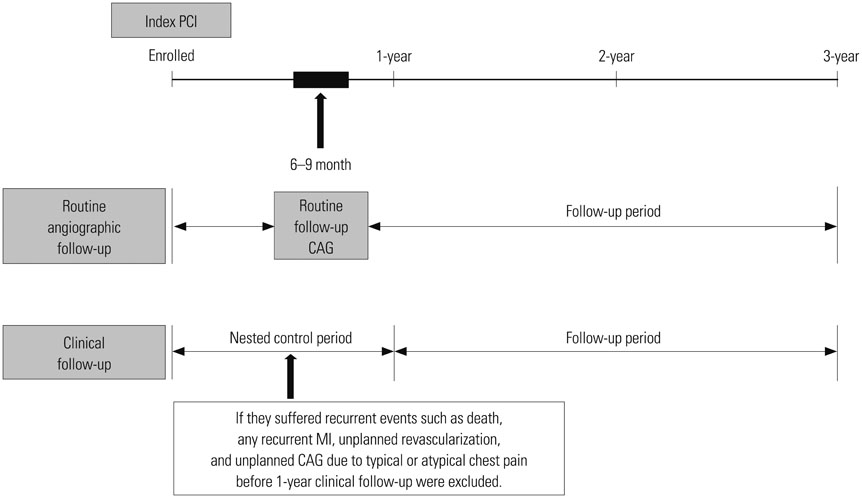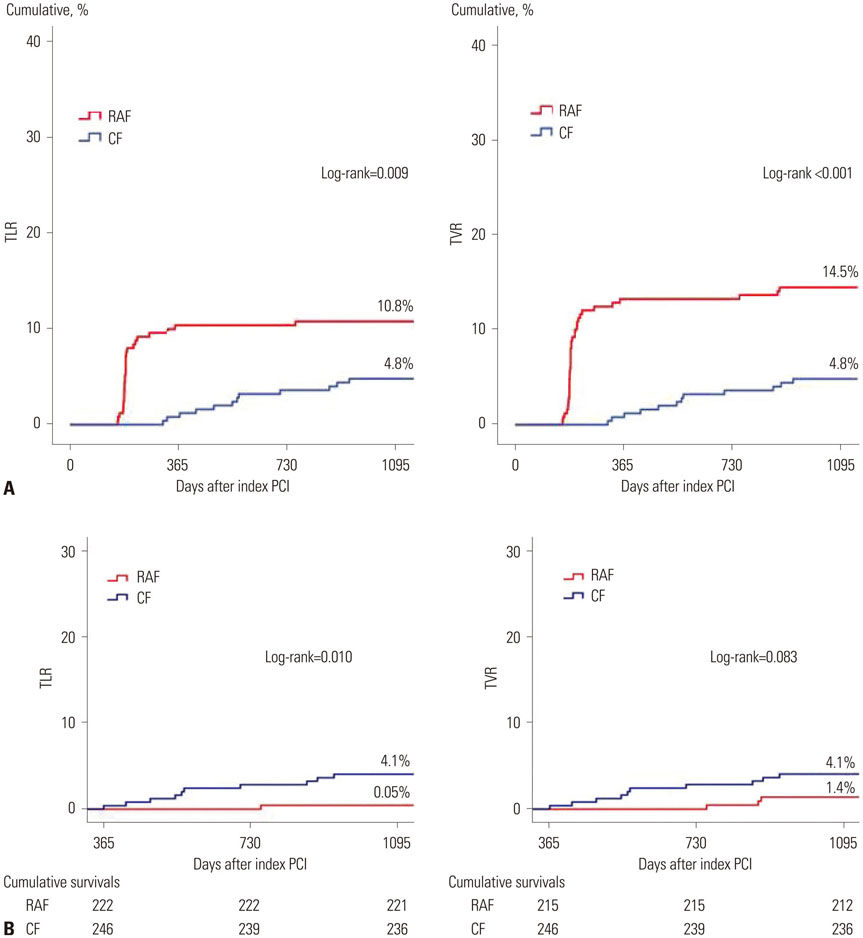Yonsei Med J.
2017 Jul;58(4):720-730. 10.3349/ymj.2017.58.4.720.
Routine Angiographic Follow-Up versus Clinical Follow-Up after Percutaneous Coronary Intervention in Acute Myocardial Infarction
- Affiliations
-
- 1Division of Cardiology, Department of Internal Medicine, Kangwon National University School of Medicine, Chuncheon, Korea.
- 2Cardiovascular Center, Korea University Guro Hospital, Seoul, Korea. swrha617@yahoo.co.kr
- 3Department of Medicine, Korea University Graduate School, Seoul, Korea.
- 4Division of Cardiology, Department of Internal Medicine, Cardiovascular Center, Nowon Eulji Medical Center, Eulji University, Seoul, Korea.
- KMID: 2419076
- DOI: http://doi.org/10.3349/ymj.2017.58.4.720
Abstract
- PURPOSE
Differences in the utility of routine angiographic follow-up (RAF) and clinical follow-up (CF) after percutaneous coronary intervention (PCI) in acute myocardial infarction (AMI) are not well understood. The present study aimed to compare the 3-year clinical outcomes of RAF and CF in AMI patients who underwent PCI with drug-eluting stents (DES).
MATERIALS AND METHODS
A total of 774 consecutive AMI patients who underwent PCI with DES were enrolled. RAF was performed at 6 to 9 months after index PCI (n=425). The remaining patients were medically managed and clinically followed (n=349); symptom-driven events were captured. To adjust for any potential confounders, a propensity score matched analysis was performed using a logistic regression model, and two propensity-matched groups (248 pairs, n=496, C-statistic=0.739) were generated. Cumulative clinical outcomes up to 3 years were compared between RAF and CF groups.
RESULTS
During the 3-year follow-up period, the cumulative incidences of revascularization [target lesion revascularization: hazard ratio (HR), 2.40; 95% confidence interval (CI), 1.18-4.85; p=0.015, target vessel revascularization (TVR): HR, 3.33; 95% CI, 1.69-6.58; p=0.001, non-TVR: HR, 5.64; 95% CI, 1.90-16.6; p=0.002] and major adverse cardiac events (MACE; HR, 3.32; 95% CI, 1.92-5.73; p<0.001) were significantly higher in the RAF group than the CF group. However, the 3-year incidences of death and myocardial infarction were not different between the two groups.
CONCLUSION
RAF following index PCI with DES in AMI patients was associated with increased incidences of revascularization and MACE. Therefore, CF seems warranted for asymptomatic patients after PCI for AMI.
MeSH Terms
Figure
Cited by 1 articles
-
Current Management of In-Stent Restenosis
Ae-Young Her, Eun-Seok Shin
Korean Circ J. 2018;48(5):337-349. doi: 10.4070/kcj.2018.0103.
Reference
-
1. Choi YJ, Kim JB, Cho SJ, Cho J, Sohn J, Cho SK, et al. Changes in the practice of coronary revascularization between 2006 and 2010 in the Republic of Korea. Yonsei Med J. 2015; 56:895–903.
Article2. Tantawy A, Ahn CM, Shin DH, Kim JS, Kim BK, Ko YG, et al. Nobori-biolimus-eluting stents versus resolute zotarolimus-eluting stents in patients undergoing coronary intervention: a propensity score matching. Yonsei Med J. 2017; 58:290–295.
Article3. Garg S, Serruys PW. Coronary stents: current status. J Am Coll Cardiol. 2010; 56:10 Suppl. S1–S42.4. Kirtane AJ, Gupta A, Iyengar S, Moses JW, Leon MB, Applegate R, et al. Safety and efficacy of drug-eluting and bare metal stents: comprehensive meta-analysis of randomized trials and observational studies. Circulation. 2009; 119:3198–3206.
Article5. Cutlip DE, Chauhan MS, Baim DS, Ho KK, Popma JJ, Carrozza JP, et al. Clinical restenosis after coronary stenting: perspectives from multicenter clinical trials. J Am Coll Cardiol. 2002; 40:2082–2089.
Article6. King SB 3rd, Smith SC Jr, Hirshfeld JW Jr, Jacobs AK, Morrison DA, Williams DO, et al. 2007 focused update of the ACC/AHA/SCAI 2005 guideline update for percutaneous coronary intervention: a report of the American College of Cardiology/American Heart Association Task Force on Practice guidelines. J Am Coll Cardiol. 2008; 51:172–209.
Article7. Silber S, Albertsson P, Avilés FF, Camici PG, Colombo A, Hamm C, et al. Guidelines for percutaneous coronary interventions. The Task Force for Percutaneous Coronary Interventions of the European Society of Cardiology. Eur Heart J. 2005; 26:804–847.
Article8. Pijls NH, van Schaardenburgh P, Manoharan G, Boersma E, Bech JW, van't Veer M, et al. Percutaneous coronary intervention of functionally nonsignificant stenosis: 5-year follow-up of the DEFER Study. J Am Coll Cardiol. 2007; 49:2105–2111.
Article9. Mindrescu C, Brener SJ, Guerchicoff A, Fahy M, Parise H, Mehran R, et al. Impact of scheduled angiographic follow-up in patients treated with primary percutaneous coronary intervention for ST-segment elevation myocardial infarction. J Interv Cardiol. 2013; 26:319–324.
Article10. Stone GW, Ellis SG, Cox DA, Hermiller J, O'Shaughnessy C, Mann JT, et al. A polymer-based, paclitaxel-eluting stent in patients with coronary artery disease. N Engl J Med. 2004; 350:221–231.
Article11. Moses JW, Leon MB, Popma JJ, Fitzgerald PJ, Holmes DR, O'Shaughnessy C, et al. Sirolimus-eluting stents versus standard stents in patients with stenosis in a native coronary artery. N Engl J Med. 2003; 349:1315–1323.
Article12. Pinto DS, Stone GW, Ellis SG, Cox DA, Hermiller J, O'Shaughnessy C, et al. Impact of routine angiographic follow-up on the clinical benefits of paclitaxel-eluting stents: results from the TAXUS-IV trial. J Am Coll Cardiol. 2006; 48:32–36.
Article13. Lasala JM, Cox DA, Dobies D, Muhlestein JB, Katopodis JN, Revtyak G, et al. Usage patterns and 2-year outcomes with the TAXUS express stent: results of the US ARRIVE 1 registry. Catheter Cardiovasc Interv. 2008; 72:433–445.
Article14. Uchida T, Popma J, Stone GW, Ellis SG, Turco MA, Ormiston JA, et al. The clinical impact of routine angiographic follow-up in randomized trials of drug-eluting stents: a critical assessment of “oculostenotic” reintervention in patients with intermediate lesions. JACC Cardiovasc Interv. 2010; 3:403–411.
Article15. Stone GW, Parise H, Witzenbichler B, Kirtane A, Guagliumi G, Peruga JZ, et al. Selection criteria for drug-eluting versus bare-metal stents and the impact of routine angiographic follow-up: 2-year insights from the HORIZONS-AMI (Harmonizing Outcomes With Revascularization and Stents in Acute Myocardial Infarction) trial. J Am Coll Cardiol. 2010; 56:1597–1604.
Article16. De Luca G, Stone GW, Suryapranata H, Laarman GJ, Menichelli M, Kaiser C, et al. Efficacy and safety of drug-eluting stents in ST-segment elevation myocardial infarction: a meta-analysis of randomized trials. Int J Cardiol. 2009; 133:213–222.
Article17. Asakura M, Ueda Y, Nanto S, Hirayama A, Adachi T, Kitakaze M, et al. Remodeling of in-stent neointima, which became thinner and transparent over 3 years: serial angiographic and angioscopic follow-up. Circulation. 1998; 97:2003–2006.
Article18. Hochman JS, Tamis JE, Thompson TD, Weaver WD, White HD, Van de Werf F, et al. Sex, clinical presentation, and outcome in patients with acute coronary syndromes. Global Use of Strategies to Open Occluded Coronary Arteries in Acute Coronary Syndromes IIb Investigators. N Engl J Med. 1999; 341:226–232.
Article19. Lansky AJ, Brar SS, Yaqub M, Sood P, Applegate RJ, Lazar D, et al. Impact of routine angiographic follow-up after percutaneous coronary intervention with drug-eluting stents in the SPIRIT III randomized trial at three years. Am J Cardiol. 2012; 110:21–29.
Article
- Full Text Links
- Actions
-
Cited
- CITED
-
- Close
- Share
- Similar articles
-
- No-Reflow Phoenomenon by Intracoronary Thrombus in Acute Myocardial Infarction
- Coronary Flow Doppler Profile in No-Reflex Phenomenon after Direct PTCA in Acute Myocardial Infarction
- Clinical and Coronary Angiographic Findings in Patients with Postinfarction Angina
- Acute myocardial infarction in young patient probably due to Kawasaki disease
- Cardiac arrest due to an unexpected acute myocardial infarction during head and neck surgery: A case report





